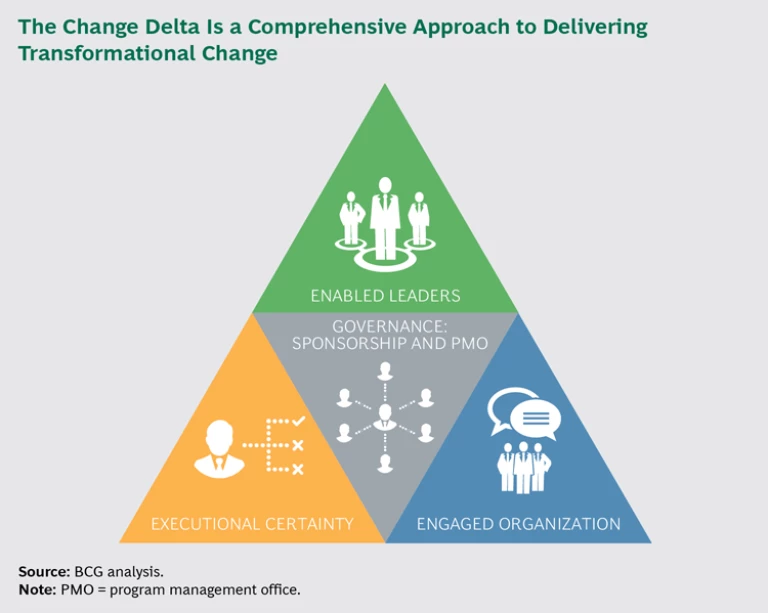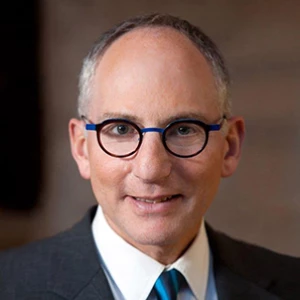The business world, like the geopolitical world, has entered a new age of uncertainty. Turbulence is affecting more and more industries, more frequently and more severely. One-time market leaders and corporate giants fall rapidly from grace, having failed to modernize or having lost out to nimble competitors. BlackBerry and Blockbuster are among the high-profile casualties. In fact, companies are expiring sooner than ever before: data suggests that one-third of all public companies will disappear within the next five years.
Companies are facing a new reality, one of economic unpredictability, disruptive technology, globalization, and unprecedentedly fierce competition. In such an environment, traditional sources of advantage like scale and proprietary assets are no longer so valuable or sustainable. The priority imperative for many businesses is to adapt to the changing conditions in order to boost performance, or even to survive.
One industry that has been a huge beneficiary of all this turbulence is the change management industry . Companies in all sectors eagerly seek its services, on the premise that a tailor-made change program will improve the trajectory of their business. Unfortunately, change programs have a remarkably modest record of success. The traditional approach to change management is itself in need of change.
Over the past few years, the change management industry has been logging an average annual growth rate of 5%. Companies around the world now spend close to a whopping $10 billion a year on change management consultancy.
Yet despite all the investment, the industry has not lived up to expectations. The evidence, including self-reported CEO data, indicates that 50% of change programs fail to achieve their objectives; the failure rate rises to 75% for more complex and ambitious programs. These rates have remained much the same for the past few decades. The failures are costly, translating into billions of dollars of lost potential value, not to mention the impact on senior executive turnover, most notably among CEOs.
Most Sectors Are Experiencing Volatility Unmatched In Decades
Since the start of the S&P 500, in the mid 1950s, company fortunes have become far less stable across industries and geographies, particularly since the early 1990s. The exhibit below shows the volatility of all US public companies in terms of their yearly changes in market capitalization. The green represents periods of stable company value; the red represents periods of widely fluctuating value. Note how even historically calm sectors, such as energy and telecommunications, have been experiencing high volatility in the past decade or two.
To put this disappointing performance in perspective, consider how other industries have fared in recent history when tackling complex challenges of their own. Never mind computing, always the outlier, with its trillionfold increase in performance over the past 60 years.
The Four Fatal Errors of Change Programs
No matter what specific changes a change program is intended to bring about—a new operating model, a superior cost position, new sources of competitive advantage—the fundamental objectives are always the same: to improve performance, substantially and sustainably, and to establish an organization agile enough to adapt to future disruptions. Those aims necessarily involve a sustained change in employees’ behavior. And for that to occur, it must be in the individual interests of employees to change their behavior—or at least in their individual interests as they perceive them to be. After all, people don’t willingly and proactively behave in ways that seem detrimental to their perceived interests. If employees are to commit to the change program and support it throughout, there has to be something in it for them as individuals. (See “The Smart and Simple Approach to Changing Performance.”)
THE SMART AND SIMPLE APPROACH TO CHANGING PERFORMANCE
Company performance is determined by, or even tantamount to, the behavior of the company’s workforce. Behavior can be defined simply as “what people do”: the decisions they make, the actions they take, the interactions they engage in. What happens in a company—from its innovations to its customer service to its key processes and capabilities—is clearly a function of what people do.
Broadly, people pursue a rational strategy when it comes to behavior: they choose to behave in ways that are in their own perceived best interests. In other words, people adopt rational, “individually winning” behaviors. That is the foundation of Smart Simplicity. Which behaviors are rational is determined by an individual’s current context; that is, the combination of rewarding or unrewarding factors that influence his or her actions, decisions, and interactions. (For most employees, a favorable context is one that provides job security and allows them to flourish in their careers. For employees nearing retirement, a favorable context might be one featuring a generous severance package; for younger employees, the ideal context might include flextime, or a prominent public role, or exciting travel opportunities.)
Viewed through the lens of Smart Simplicity, a company is a system of rational strategies pursued by individual employees. Fortunately, most of these strategies tend to be widely shared among the workforce. It’s by understanding and shaping those strategies that executives can effect change. And the way to get individuals to change their strategies and hence their behavior sustainably—and consequently to boost company performance—is to change their contexts so that the behaviors conducive to the change program are also in the individuals’ best interests.
In any change program, there will inevitably be losers as well as winners among the staff. One painful prospect is that some of them might have to be laid off; others might have to take on roles that they did not originally want. However, all employees will still behave in their own perceived best interests, given the options available to them. So the challenge is to adjust the context in such a way that their best interests are served by cooperating as fully as possible with the program rather than resisting or undermining it.
For a fuller discussion of this “rational strategy” approach to workplace behavior and hence to corporate performance, see Six Simple Rules: How to Manage Complexity without Getting Complicated, by Yves Morieux and Peter Tollman (Harvard Business Review Press, 2014).
Unfortunately, only a minority of change programs change employees’ contexts sufficiently to produce the new behaviors that the program requires. Accordingly, many change efforts fail. Numerous factors can contribute to this failure, of course, but it’s worth looking at four particular errors that companies tend to make repeatedly—the four fatal errors, so called because they fatally undermine change efforts and frequently the credibility of the people leading them. Like most of the best fatal errors, they seemed like excellent ideas at the time and remain extremely appealing, so companies keep repeating them—and keep getting the same results. Our formulation of the four errors is distilled from more than 50 years’ collective observation of companies in all major industries around the world. For obvious reasons, the case studies cited below have been anonymized and hybridized.
Fatal Error 1: Neglecting Employees’ Individual Interests. Consider the case of a global industrial goods company that wanted to improve its sales forecasting. Sales forecasting serves many purposes, and these can sometimes conflict with one another. For example, forecasting is used for setting expectations, both internally for budget purposes and externally for earnings guidance; but it’s also used for determining manufacturing volumes and inventory-carrying levels. In making estimates, the company’s sales-forecasting team proved consistently conservative, and each year the sales team ended up selling substantially more than was forecast. Stockouts would sometimes occur, therefore, and the manufacturing team was held responsible. So the manufacturing team ceased trusting the sales forecasts and started to add an unofficial, roughly calculated buffer to its production quotas. As it happens, the manufacturing team was not held responsible for excess inventory and therefore consistently erred on the side of overestimating the required inventory. In consequence, the company’s annual inventory-carrying costs were $120 million higher than necessary.
The company duly set about changing its approach to forecasting in order to make it more reliable and more relevant for everyone involved. Senior leadership, including the CEO and COO, presented a compelling case for change and tailored messages for each of the three teams—forecasting, sales, and manufacturing. The forecasting team would have to review and update its techniques in order to improve the accuracy of its forecasts; the sales team would have to make contingency plans in the event of stockouts; and the manufacturing team would have to stop buffering and produce only as much as the forecast indicated. Such adjustments would be difficult, but they would materially reduce inventory costs and help the company meet critical profit goals. The response from the workforce appeared to be enthusiastic, and the program launched in a very positive spirit. All to no avail.
The trouble was that the designers of the change program had failed to consider people’s individual interests. It’s not enough to present a compelling case for change. Change practitioners might invoke the fashionable phrase “burning platform” to convey the sense of crisis; they might explain how the specified changes are in the company’s interests and the collective interests of all employees; they might segment their audience carefully into different stakeholder groups and customize their appeals to each of them. And, quite possibly, all employees will be convinced that the change program is in the collective interest, but many of them will still obstruct the program, perhaps unwittingly, by failing to adjust their behavior as required. (Arguably, this familiar outcome has been an important force in shaping, or misshaping, the change management industry: many supposed experts have mistakenly characterized the obstructionists—especially those in middle management—as behaving emotionally or illogically, and have continued to refine their remedies for that imaginary malaise!)
In what way were individual interests opposed to the collective interest in this case? Why did conservative forecasting remain the rational choice for the forecasters? The underlying issue, which the leadership had overlooked, was that the forecasting team resided within the commercial division, which was compensated on the basis of sales performance relative to budgeted targets. It was in the forecasters’ interest, therefore, to set conservative targets that they could then substantially exceed: in that way, they and their commercial-division coworkers would receive handsome bonuses. An accurate forecast, in contrast, would threaten and thereby incense the senior sales managers—the very people who could most affect a forecaster’s salary or promotion prospects come the annual review.
The manufacturing team likewise had a perverse incentive: to overestimate upcoming sales and thereby reduce the risk of stockouts and the associated blame. The manufacturing team, however, had no power over the forecasting team and no way of encouraging it to provide higher forecasts. To avoid underproducing, the manufacturing team had no choice but to persist with the buffer. And because the team was not penalized for excess inventory, it tended to overproduce by a considerable margin. That is how the excess-inventory crisis was born.
As this case study demonstrates, the collective interest is all very well, but for individuals to change their behavior, it must be in their individual interests to do so. Inevitably, there will be some costs to employees in any change program, but the behaviors required for change can still be in their individual interests if there are benefits that, on balance, make it rational to get with the program. It’s up to leadership to understand these cost-benefit analyses and tip the scales as needed to make active support of the collective change an individually winning strategy.
What happened at the industrial goods company when the program was launched? Nothing much, and that was the problem. The on-the-ground reality of the fore- casters—their individual contexts—remained unchanged, so they had no real incentive to change their ways. They might have paid lip service to the rallying calls, and perhaps they even believed that they should and would comply with the change program by making more refined and less aggressive forecasts. But it was not in their individual interests to do so.
Despite the declared enthusiasm for a new style of forecasting, then, the forecasts remained conservative in practice, and the manufacturing team continued to ignore them and overcompensate. The change effort was judged a failure, and its leader—a former rising star within the company—ended up leaving the firm.
Fatal Error 2: Underengaging the Extended Leadership Team. In advance of the launch of a major change program, it’s crucial to get the extended leadership team seriously engaged. (In a large organization, this team consists of the top 150 executives or thereabouts.) Unfortunately, a great many companies delay such an engagement effort until well after the launch, and many never get around to it at all.
Take the case of a large bank that had attempted several change programs over five years without achieving any truly beneficial changes. Its most recent program was aimed at reducing risk taking on the part of its loan officers. By selling financial products to high-risk borrowers, those loan officers had created serious problems in the past, and the company’s loan portfolio was still worryingly exposed. The executive committee was eager to direct the loan officers’ behavior toward greater prudence. A
program management office (PMO)
was promptly established, and, in concert with the executive committee, it duly devised and activated a change program.
Members of the extended leadership team, however, were generally left on the sidelines. They had little input into the program’s design or early implementation. Instead of feeling like owners of the change, they felt underconsulted, underutilized, and underinformed—and, consequently, disrespected. Their direct reports sensed and therefore shared their lack of enthusiasm. For the workforce, accordingly, the PMO team had little credibility, and one year after launch the risk reduction program remained largely unimplemented. Not surprisingly, the risk profile of borrowers showed no discernible difference from that of the previous year. When called to account by the board, the PMO ascribed the failure to “blockage from the extended leadership team”—referring to that team’s failure to amplify and support the PMO’s reform agenda. Meanwhile, the riskier borrowers began defaulting in large numbers. The change program had proved to be little more than an expensive vanity exercise.
What the executive committee failed to realize is that engagement of the extended leadership team is pivotal in translating a change program’s goals into actual workforce behaviors. No matter how inspiring the speeches from senior leaders may be, employees tend to listen to their direct manager more than to a C-suite executive. Proximity trumps seniority. They are aware that the direct manager has more influence over their professional fate—job security, status, salary increases, promotion prospects. And the direct manager, if properly engaged and equipped, is much better positioned to answer the crucial question, “What does the change mean for me, my team, and our customers?”
To align the rank and file with the change program, you need to get a critical mass of extended leadership team members on board—70% or more, in our experience. Unless they have a personal stake in the change program, they will likely have little commitment to it and little incentive to rally the rest of the workforce. This personal stake can be generated in several ways. Give the extended leadership team members a voice earlier on in the program, for example, and they will feel a greater sense of ownership and will contribute more readily. In fact, their involvement should begin as early as the design stage: after all, they know the workforce and the situation on the ground better than the PMO or the senior sponsors do. Giving them the opportunity for meaningful input will make them feel included in the program and enthusiastic about it, and will also help keep the program free of design flaws.
Fatal Error 3: Failing to Sufficiently Empower the PMO. An oil and gas company had been conducting refinery enhancements and other focused engineering projects, all supported by a technically proficient PMO. The company was now embarking on a more ambitious, enterprise-wide transformation aimed at greatly boosting uptime at the refineries and improving efficiencies between upstream and downstream operations—a program that was meant to generate more than $700 million in annual savings. Senior management assumed that the PMO, with its existing setup and staffing, could handle the transformation and duly put it in charge. Given the PMO’s impressive record, there seemed to be no reason to change its structure or composition.
A few months after launch, the simpler initiatives were progressing well. But the more complex initiatives, where the bulk of the value lay, had stalled. The change program as a whole was not delivering according to expectations, and senior management ordered a fundamental review.
The review attributed the setback largely to two broad issues: first, a failure to identify, flag, and address critical delivery risks for the more complex initiatives; and, second, an inability to confirm that all the crucial and interdependent factors were in place. The reason for those shortcomings, in turn, was that the PMO lacked adequate power. (Power in this context is influence over things that are important to others. Having such influence allows one to affect outcomes related to their interests and thereby encourage them to modify their behavior. Power can derive from an obvious source, such as a reporting relationship, input into a performance review, or control over budgets. It can also derive from a subtler source, such as access to specialized information, a particular expertise, or the backing of a senior leader.)
The PMO was unable to order a thorough risk assessment prior to launch, raise concerns with senior management and arrange a course correction, or compel initiative leaders to participate. When the PMO asked those leaders to issue regular reports on the status of key risks, most of them simply filled out the PMO’s template without describing the risks sufficiently, without specifying changes in the risks’ drivers or magnitude, and without discussing any need for support. Some of the initiative leaders did not even bother to fill out the template, despite multiple reminders from the PMO. All in all, the PMO was thwarted in one of its crucial roles: that of accurately distilling and communicating the risks involved, and thereby giving senior management the opportunity to mitigate them.
This type of failure is alarmingly common. A PMO should be a steward of value for a change program. To play that role effectively and support senior leadership properly, a PMO needs adequate power. And to gain that power, it needs sufficient visibility into the various units and the means to influence behavior in them, especially to increase cooperation across the enterprise. A PMO will also benefit if it has prominent rising stars or seasoned leaders on its staff: the presence of rising stars signals to the organization that the PMO is to be taken seriously, and the presence of seasoned leaders indicates the PMO’s deep knowledge of and interest in the long-term performance of the organization. Absent such signals of power, initiative leaders will perceive the PMO as marginal rather than powerful, and it will have limited ability to shape people’s behavior in line with the objectives of the program.
Fatal Error 4: Allocating “Set-and-Forget” Targets. A company may be keen to empower its initiative leaders, to entrust them with considerable autonomy over budgets and resource allocation. But this well-intentioned policy can break down when it comes to more complex change initiatives, especially those involving shifts in strategy or changes to an organization’s operating model. The case of a major credit card company illustrates the perils.
Under a newly appointed CEO, the company was embarking on an ambitious transformation program centered on shifting to a lower-cost operating model. The program involved an array of initiatives, including a cost reduction target for each department. The organization had historically followed a distinctly “federated” model, in which departments were led by strong managers who all favored the same traditional procedure: being assigned a target and then being left alone to get on with reaching it. The new CEO, in furtherance of the transformation program and in keeping with her own more rigorous approach, attempted to introduce various organizational reforms: joint executive-level redesign of the governance model, C-level visibility into the progress of the program, an increase in cross-functional cooperation, and a consistent and systematic tracking scheme based on key milestones. The initiative leaders regarded all of this as an encroachment on their turf and a lack of trust in their ability to execute. They resisted. The CEO changed tack, not wishing to undermine them early on, and for the next three years simply announced the annual targets and let the departments take responsibility for them. The hope was that assigning the targets, and then standing back, would be enough.
Such a policy may work for simple initiatives, but for more complex initiatives it’s almost always inadequate. Simply setting annual department-level targets will generate behaviors that are short-term and incremental without challenging the business model or striving for sustainably higher productivity. Complex change programs demand a more sophisticated model—a model that includes forward-looking indicators, allows for course corrections, encourages creative and cooperative solutions, including cross-department solutions, and keeps senior management appropriately involved.
The hands-off, set-and-forget model for allocating targets has three major shortcomings. First, if senior management neglects to inspire ambitions, to monitor progress and make proper course corrections, and to show sufficient engagement, then the initiative leaders will have little reason to go the extra mile. Presented with an annual target, they will likely focus on measures that aim simply to meet it—typically shortsighted cost-cutting measures such as restricting travel or delaying recruitment. After all, such measures are far easier to implement, and far less threatening to the delivery of day-to-day business results, than broad long-term measures such as seeking sustainable savings through increased productivity. Taking the simpler path is the rational choice when you have a very serious day job and understandably want to minimize disruption. Unfortunately, the short-term measures don’t change productivity fundamentally or sustainably. Sooner or later they are discontinued, and when that happens, the benefits evaporate.
Second, the initiative leaders will likely seek solutions specific to their own departments rather than pursue opportunities that might contribute to collective, cross-department success. In fact, those promising opportunities, potentially conferring a competitive advantage, often remain undiscovered, since individual departments left to their own devices have no particular incentive to look beyond their silos. They might even have a disincentive to do so, because they may rightly worry that they wouldn’t get their fair share of credit for the results or that it would be a futile mission and damaging to their prospects.
Finally, the hands-off model militates against lead-indicator metrics, timely interventions, and course correction. If senior leaders have little visibility into a departmental initiative, they cannot easily realize that things are going off track—through the pursuit of unsustainable, short-term measures—until it’s too late to do anything about it.
So how did the credit card company fare? In the first year, almost all the departments met their targets. In the second year, most missed them. By the end of the third year, overall costs had returned to their original unsatisfactory level. So much for the transformation! Disappointed and exasperated, the CEO commissioned a detailed review to try to establish how the program had gone wrong. The review found that the program—just like several previous change programs—had emphasized quick-win streamlining rather than sustainable cost savings and that it had neglected to pursue, or even identify, attractive cross-department opportunities. The CEO should have stayed the course in the early days: when the initiative leaders resisted, she should have persevered in backing the program’s original design, and, leveraging her executive team, she should have sought a sustained productivity boost by insisting on the rigorous tracking and management of initiatives.
The Root Cause: Failure to Make the Change Rational for Individual Employees
The four fatal errors share one particularly salient feature. In all four case studies, the change program failed to get people truly on board—to get them to adopt behaviors that were aligned with the success of the program.
No matter what a change program aims to do—boost productivity, realize synergies from a postmerger integration, or implement an innovative business model—it must first and foremost secure the buy-in of the workforce. For that to happen, all employees need to see that supporting the program is feasible and is in their individual interests. Each of the four fatal errors, in its own way, obstructs that crucial buy-in, so the requisite behavioral changes do not take place, and the change program falters.
How should a company go about securing the support of employees for a change program and getting them to adjust their behavior in its service? Our approach is Smart Simplicity, a framework for understanding—and enhancing—modern organizations. For a very brief account, see the “A Glimpse of Smart Simplicity.”
A GLIMPSE OF SMART SIMPLICITY
Smart Simplicity provides a new lens for viewing organization issues, one that is more effective than that of traditional management approaches and is particularly powerful for organizations intent on change.
Its key premise is that corporate performance is based on employees’ individual behavior (decisions, activities, interactions) and that employees choose behavior that is their individual best interests, given their current contexts.
For a change program to succeed, then, the imperative is to change employees’ contexts in such a way that the employees’ perceived individual interests become aligned with the interests of the company as a whole, and that it makes sense for the employees to cooperate as a team in the service of those interests.
The desired behavior can be elicited first by giving employees the ability to act in the organization’s best interests—specifically, by giving them appropriate resources, removing constraints, and creating transparency about what they and others do; and second, by increasing employees’ desire to act in the organization’s best interests—in other words, motivating them—specifically, by linking consequences tightly to action, requiring reciprocity and eliminating dysfunctional self-sufficiency, and rewarding cooperation. (Cooperation, in this sense, involves taking actions to improve the performance of a colleague or the organization as a whole, even if inconvenient to oneself.)
Smart Simplicity recognizes that an organization is a system of the individual rational behaviors of the people who constitute it, so the way to change the performance of the organization is to make new behaviors rational.
Addressing the Root Cause
Another helpful resource in this regard is the Change Delta, a framework—drawing on decades of change management experience across the globe—that company leaders can use to manage major organizational change. Its value lies in managing a program of change rather than an individual project or initiative.
The Change Delta converts the principles of Smart Simplicity into practice. It encourages the desired behaviors by making them rational. It ensures that individual employees are not only aligned with the objectives and norms of the change program, but also have reasons to actively engage with it so that they make the right decisions and execute them efficiently. The Change Delta’s four components, or aspects, are strongly interdependent and jointly optimize the program’s structure and implementation. (See the exhibit.)
Here is a brief account of the four components. A more detailed discussion can be found in Changing Change Management: A Blueprint That Takes Hold (BCG report, December, 2012).
Governance: Sponsorship and PMO. The formal oversight of the change program—the governance—is typically the responsibility of two entities: the sponsor, or set of sponsors, and the PMO.
In the case of a company-wide change, the sponsor is likely to be the CEO; for a change program designed for a business unit or division, the sponsor will likely be the head of that unit or division. (In many change programs, governance cascades down the organization, so some divisions have their own sponsor and PMO for their portions of the program.) The sponsor has ultimate responsibility for achieving and sustaining the transformation that the program was designed for.
The sponsor is frequently supported by a steering committee, which might be a group of senior leaders convened for this purpose or the senior leadership team of the organization or business unit. The senior leaders involved will help guide and shape the program and might, individually, be accountable for specific parts of it. Among their tasks are energizing initiative leaders and participants, listening to feedback, removing roadblocks, ensuring sufficient resourcing, helping initiative leaders recognize and resolve problems early on, and rewarding the workforce when milestones are met.
The sponsor empowers the PMO and initiative leaders, and checks that the PMO is fully aligned with his or her vision so that the governance team as a whole speaks with one voice and is clearly seen as unified. Sponsors must take care to provide the right level of input; they should find sufficient energy and time for the program.
The PMO oversees the program operationally, ensuring that each initiative is properly chartered, resourced, and organized for success. As the steward of value, the PMO promotes cooperation across the organization in support of the change program. It helps to bring all initiatives into alignment, monitors progress, and keeps the sponsor and senior leaders informed so that they can take action promptly when needed. When issues arise, the PMO makes sure that the appropriate conversations occur and that initiative leaders understand their accountabilities and are equipped to implement them.
The PMO leader might be involved in the design of the overall program and in choosing the blend of initiatives best able to achieve the program’s goals.
Executional Certainty. Given the complexity of large-scale change programs, senior leaders face a tough challenge in overseeing them and guiding them to success. Organizations can overcome that challenge through executional certainty—a set of activities aimed at providing senior leaders with a clear grasp of each initiative’s purpose, operational insights, and regular progress reports. Rather than hearing the dreaded words, “There’s an issue that’s been simmering for some time …,” senior leaders can identify issues early and resolve them speedily. A set of tactics and tools to accomplish this responsiveness has been developed and refined over the past 20 years and has been embraced by organizations around the world.
Broadly, the activities are as follows: assessing upfront the design of the initiatives and the way that the teams are constituted; maximizing understanding of the key milestones and intended impacts; and providing forward-looking indicators that will prompt timely course corrections. To avoid overburdening the senior leaders, the activities should be carried out with minimum sufficiency: for instance, only the most critical information is reported to the senior leaders, giving them an overview of progress and equipping them to act quickly and decisively.
Various tools are available for facilitating executional certainty, such as Rigor Testing, Rigorous Program Management (RPM), and DICE.
RPM ensures efficient tracking and reporting of the progress of a program, and helps guide senior leaders’ decisions. In other words, it reinforces their organizational power with operational insights. Regular progress reports enable senior leaders to affirm and encourage when things are going well and to make course corrections when things are going wrong. A crucial component of RPM is the initiative roadmap, which characterizes each initiative by listing the essentials: 5 to 20 milestones, the main risks and interdependencies, and early-warning indicators. The roadmap is a statement of the initiative’s targets and the main measures required for reaching them. It keeps the initiative team focused and motivated, and it clarifies accountability so that all participants feel the consequences of their actions promptly—a key tenet of Smart Simplicity.
In general, executional certainty ensures that the change program is set up for success from the start and applies the first and most fundamental rule of Smart Simplicity—understand what people actually do—to monitor progress and identify the changes in behavior that would get initiatives back on track.
Enabled Leaders. Even though a change program is initiated and sponsored by the company’s top leadership team, the real driving force is the extended leadership team, fully aligned and activated. (The extended leadership team consists typically of the CEO, the CEO’s direct reports, their direct reports, and select layer 4 and layer 5 managers. In a large organization, the team might, as mentioned earlier, consist of the top 150 senior managers.) These individuals are crucial for overseeing the program to completion. And because of their proximity to employees, they are also in the best position to engage the full workforce in meeting the program’s goals and to secure buy-in from the entire organization. Employees generally respond better to their immediate or near-immediate supervisors than to more-distant senior leaders, since it is these proximate supervisors who influence most strongly the stakes that matter to employees, such as project assignments, performance reviews, and opportunities for advancement.
To be properly enabled, the members of this extended leadership team need to have a vested interest in the program’s success. They should also be aligned in their views on how to attain that success: again, they should speak with one voice. They must be committed to the program, eager to own and lead it, and responsible for its results. Duly empowered and included early on, they will exercise their power to garner support for the program among the broader organization—by ensuring in turn that it’s in each employee’s individual interest to participate fully.
Engaged Organization. An engaged organization is one that is motivated and equipped to support the change effort. A change program relies crucially on the buy-in of employees, so the program must be designed in such a way that they are willing and able to adopt their assigned roles and to complete their specified workload—willing, because it’s now in their best interests to comply; and able, because they now possess the requisite tools, information, and power. (Skills building might be required, but that, too, can increase employees’ engagement.) More broadly, in keeping with the tenets of Smart Simplicity, the design of the program should aim to create a context for employees that makes it rational for them to actively help the program succeed.
The starting point in creating and maintaining employee engagement is thoughtful and effective communication. All participants, at every level, need to understand clearly the program’s rationale and design, its role in driving the organization’s strategy, and their own roles and responsibilities within the program. The messages may need to be repeated and reinforced regularly. Even a brilliantly designed change program will likely founder if participants remain uninformed or unconvinced of its virtues.
An engaged organization is all the more important now, in light of the growing millennial and generation Z presence in the workforce. Generally speaking, these employees seek greater meaning from their work than their premillennial counterparts did—and they are more amenable to job mobility. With their skill sets and aspirations, they expect to have some input or at least insight into senior management’s key decisions and will readily change jobs if they feel marginalized. The new norm in organizations, both in regular times and in times of change, is greater openness, better communication, and increased employee involvement in decisions.
The Four Elements in Concert
Bear in mind that the four elements of the Change Delta depend heavily on one another. Jointly, they bring energy and clearer accountability to the delivery of the change program. If all four elements are working optimally, several happy outcomes emerge: operational insight is maximized; people feel that they are being treated respectfully, and the leaders and lines are engaged actively and harmoniously; the overall effort is pursued with consistency, with rigor, and ultimately with success; and foundations are laid for even bolder change in the future.
Farewell to the Fatal Errors
Suppose that the companies in the case studies cited earlier had all recognized the shortcomings of their initial attempts and had turned to Smart Simplicity and the Change Delta for help in approaching their change programs. In that alternative world, things would have worked out very differently.
Smart Solution 1: Making Participation Individually Rewarding. The industrial goods company had a serious challenge on its hands. When appeals to the common interest failed to work, leadership resolved to find an explanation for the forecasters’ persistence in making overly conservative forecasts. Clearly they must have had some motive for doing so—some rationale grounded in their individual interests. An investigation concluded that matters would not improve as long as the forecasters remained in the commercial division, with their futures dependent on positive feedback there, and as long as the manufacturing team perceived a much larger downside to stockouts than to excess inventory.
Armed with this new understanding, the executives sponsoring the change program began afresh. They again formulated a cogent case for change and publicized the collective benefits, but this time they arranged some changes of their own: henceforward, the forecasting team would report to a business support team—which provided services to the commercial and manufacturing divisions but did not report directly to either of them—and would be assessed and rewarded for accuracy. The business support team would regularly check the sales forecasts to ensure that they reflected expected business growth and would encourage the forecasting team to adopt the latest, most sophisticated methods. Moreover, the manufacturing team, while still being held accountable for stockouts, would also be accountable for the carrying costs of excess inventory. Sure enough, the forecasters and manufacturing team began to view things differently: the forecasters found conservative forecasting to be less attractive than before, and they now had a personal incentive to move to the new system, while the manufacturing team no longer felt compelled to build in a large buffer.
Smart Solution 2: Extensively Engaging the Extended Leadership Team. The senior executives of the bank reviewed their previous, failed efforts at promoting cultural change and determined to redesign the program. This time, there would be an emphasis on getting the extended leadership team involved and aligned with the change program as early as possible. The program’s sponsors organized a comprehensive communication and enablement package, including a two-day leadership summit and face-to-face follow-up meetings, to clarify the purpose of the transformation and listen to participants’ concerns and suggestions. The extended leadership team explained, for instance, why current, damaging practices persisted (why the practices were a rational choice for the loan officers) and debated how the sponsors might change the program (in order to make the new, favorable practices rational instead). The extended leadership team also explained to the senior leaders the serious mismatch that the current system permitted: the loan officers who made numerous high-interest loans received higher bonuses, earned greater respect, and gained promotion faster, regardless of how risky the loans were, whereas the impact of the associated risk (in terms of failed loans) took years to hit the books—by which point many of the loan officers had moved to other positions or other companies.
The senior leaders were now in a position to make several organization-wide modifications aimed at reducing the appeal of excessively risky behavior. They implemented an incentive system for the loan officers that penalized rather than rewarded those who took extravagant risks. They also reinforced the extended leadership team’s determination to reduce risk: they rallied the team’s leadership instincts by warning that a persistently risky loan portfolio could lead to layoffs among the staff, and they offered the team a bonus if the risk of the portfolio decreased to an acceptable level.
The members of the extended leadership team, having been engaged early on and properly empowered, felt that they owned the change agenda and were the right people to see it through. Their commitment was intense, both through being at the frontline and through realizing that their own success was linked to the success of the program. They communicated to their teams the new vision for the company, coached individual employees on new behaviors, and enhanced the change program by removing obstacles.
Their strong engagement cascaded down to the sales teams and individual loan officers. It could not have come at a better time: the industry was going through a particularly troubled phase. The company was nevertheless able to deliver impressively on almost all aspects of the change program, not only weathering the storm but emerging in far better shape than before, having shifted the portfolio to a less risky and longer-term customer base.
Smart Solution 3: Empowering the PMO. At the oil and gas company, senior executives agreed that if the productivity transformation was to make good, it needed a “PMO with teeth.” An underpowered PMO would be unable to corral the initiative leaders, who would instead persist in focusing on their day-to-day duties. During the planning stages, senior leaders put a lot of thought into the ideal setup for the PMO—its reporting relationship with them, its mandate, and its resourcing. The PMO was now assigned the requisite authority, was duly anointed as a steward of value in support of senior leadership, and was staffed by up-and-coming, high-potential leaders who would report directly to an influential member of the executive team.
One notable achievement of the PMO was shaping how initiative leaders thought of risk and reported it to the senior leadership team. In keeping with standard practice, the PMO helped them analyze risk-based information and use it in setting milestones; but the PMO also went one step further, asking initiative leaders to describe the risks most likely to derail each project and to suggest the leading indicators of these risks. For instance, in an initiative aimed at building up capability for assessing geological sites to acquire, a leading indicator was the number of attractive candidates applying for the technical roles. When it emerged that insufficient high-quality candidates were applying, senior leadership was able to intervene promptly and hire specialist recruiters to help bridge the talent gap.
With the backing of senior leadership, the PMO was willing and able to coordinate the units involved, promote cooperation across lines, and drive the program to success. Note that the PMO’s charter was not to usurp but to facilitate the work of the initiative leaders, raise issues on behalf of senior leadership, and alert executives promptly to any intractable problems.
The initiative leaders accorded the PMO a grudging respect and ended up cooperating beyond the minimum specifications: they offered valuable operational insights, adjusted their focus in order to harmonize with other initiatives, spontaneously raised early concerns about hitting targets, and put forward their own ideas for course correction.
Smart Solution 4: Effectively Defining and Tracking Progress. The credit card company’s new CEO was respectful of the federated corporate structure that she had inherited, but she made it clear to department leaders that their cost reduction efforts would now be checked and reported by the PMO, backed by the steering committee—though just enough to foresee major risks and allow for corrections. Heartened by this relatively hands-off approach, the department leaders agreed to various changes: they would develop and apply forward-looking metrics, they would cooperate fully with the PMO in rigor testing the change initiatives, and they would ensure transparency on the issues that particularly concerned senior management. In addition, they would lend their support to developing a number of cross-department initiatives.
The CEO reassured them that the PMO would not weaken their authority or threaten their autonomy: the reason for the PMO’s increased involvement was the complexity of the change program, in particular the many cross-functional dependencies involved. As the CEO put it, effective oversight had to be implemented in order to give senior leadership the necessary operational insights and the means to intervene and suggest course corrections early enough to make a difference. In general, the change program would be wielding a scalpel, not a jackhammer.
During the design phase of the program, the PMO stress tested the initiatives—their risks, likely financial impact, and realistic milestones—which were duly incorporated into the final version of the program. The PMO also instituted a monthly meeting at which department heads shared ideas for identifying and changing unproductive behaviors among their staff, and discussed opportunities for cross-department cooperation that would increase productivity. The CEO took to attending these meetings and publicly recognizing bold suggestions; in due course, the department heads who could not propose creative, cooperative solutions were perceived by their peers to be letting the program down.
The effect was as much preventive as curative. The department managers—appreciative rather than resentful of the coordination effort—strove to reach each milestone punctually. When things deviated from the roadmap, the PMO was alerted promptly and initiated early course corrections. The PMO took care to consult the relevant team leaders about the best intervention and let them take the lead in getting back on track. The department leaders, even while working intently at meeting their monthly targets, were motivated to look beyond their silos and beyond the short term and contribute to a sustainable, company-wide performance boost.
Changing for the Better
The Change Delta, with Smart Simplicity at its core, has proved its potency time and again. Companies around the world have benefited from it, averaging 110% of targeted performance improvements across a range of challenging and complex change programs. Compare that with the industry average of 50% to 75% failure rates (with the more complex programs registering the lower scores).
What of the future? As digital technology grows ever more powerful and more widely applied, exploiting it for change management purposes will pose new challenges and opportunities. We expect an increasing shift toward “agile” project delivery approaches and other working models (involving more mobile talent, for example). We also expect even greater employee involvement and an increase in bottom-up input relative to top-down direction. But Smart Simplicity and the Change Delta will remain valid.
Using a set of minimally sufficient but proven approaches, the Change Delta promotes cooperation by aligning people’s interests with those of the program as a whole. In doing so, it fulfills the key ambitions of any change program—to bring about sustainable improvements in performance (without undue disruption), to enable as many people as possible to experience the change in the most positive way possible, and to build the capability for even bolder change.
By using the Change Delta, and the Smart Simplicity principles on which it is based, organizations will change the prospects of their change programs for the better, and the change management industry as a whole will live up to its claims and fulfill its potential.
Acknowledgments
The authors would like to express their gratitude to Yves Morieux, a senior partner and managing director in BCG’s Washington, DC, office, and their deep appreciation for his pioneering work in the area of improving organizational effectiveness. This paper draws heavily on the Smart Simplicity framework developed originally by him and detailed in Six Simple Rules, which he coauthored with Peter Tollman.
The authors have benefited greatly from the direct input of many BCG colleagues. Particular thanks go to Jeanne Bickford, Tapio Schrey, Trish Clancy, Andre Pinto, Michael Shanahan, Aaron Snyder, Mike Lewis, Jennifer Bratton, Roselinde Torres, Rolf Bixner, Jürgen Schwarz, Reinhard Messenböck, and Kilian Berz. Thanks also go to Jennifer Tankersley and Annabel Doust of BCG’s People and Organization and Operations practices for their analysis and insights.











